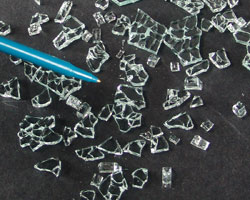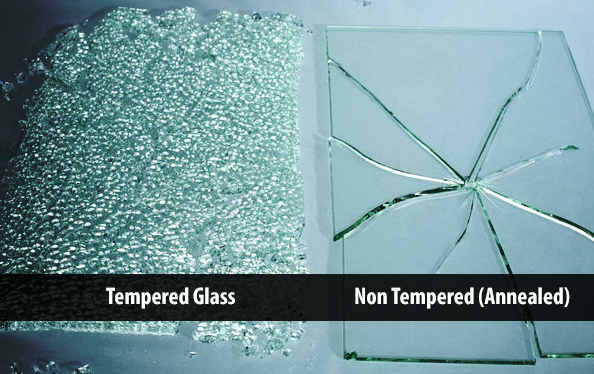Safety Glazing
Building codes can vary somewhat on where safety glazing is required and how the local inspectors interpret the requirements, so check locally! What you see below are just generalized interpretations of the codes. Safety glazing requirements are to make sure that glass or windows that are installed in “hazardous locations” are less likely to cause injury.
What is safety glazing?
Generally there are two types of safety glass that are used in windows; tempered glass and laminated glass. Tempered glass has been heated and then cooled quickly in such a manner that it becomes 4 times stronger than regular glass but also, when it does break, it breaks into small pieces that are less likely to cause injury. Laminated glass is the other type of safety glass; the windshield of your car is a good example of this type of glass. Regular laminated glass is no stronger than other types of glass, but it is made up of two pieces of glass with a clear plastic interlayer between them. When laminated glass breaks, the interlayer holds the pieces together so the risk of injury is low. Yes, it is possible (but expensive), to get laminated glass made with tempered glass.

Usually tempered glass will have a small semitransparent stamp in the corner from the fabricator identifying it as tempered. Laminated glass may or may not have a similar stamp depending on the fabricator.
What qualifies as a hazardous location?
Well besides places like battlefields and coal mines, hazardous locations are places where it would be easy to fall into a window and get hurt.
1. All glass in and around shower and tub enclosures are required (any glass less than 60” from the standing surface of a tub or shower) to have safety glazing so that if you slip on a wet floor and fall into a window you won’t get cut badly.
2. Another hazardous location is around doors. In general, any glass in a door, or glass within a 24” arc of a door, is required to be safety glass. The exception is if it is more than 60” above the floor; so a window above a door (a transom), often does not need to be safety glazed.
3. If a window is less than 18” above the “walking surface” and more than 9 square feet in size it needs to be safety glazed.
4. Windows in stairways generally need to have safety glass in them when the bottom of the window is less than 36″ above the stairway or landing.
5. Non window applications and locations considered hazardous and requiring safety glass are glass guards and railings, glass in skylights, or any overhead roof or sloped wall.
Again, check your local building codes for specifics on all of these or have a look at
http://publicecodes.cyberregs.com/icod/ibc/2009/icod_ibc_2009_24_sec006_par001.htm
Safety glass is often used in conjunction with low-e glass so you get your efficiency and your protection. For more information on glass, or to see what we offer, please call our offices or stop by our shop and showroom for a hands-on look. If you would like a consultation on the windows in your home please contact us for a free, no pressure estimate.


